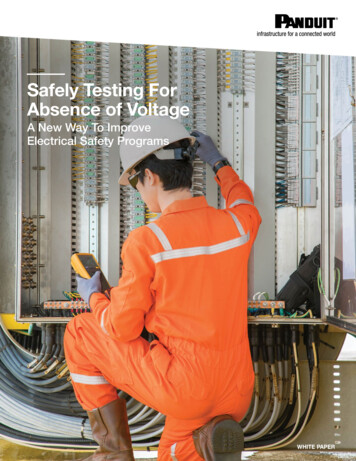
Transcription
Safely Testing ForAbsence of VoltageA New Way To ImproveElectrical Safety ProgramsWHITE PAPER
More Meaningful ConnectionsDe-energizing equipment, following adequate lockout/tagout procedures,and verifying the absence of voltage are key components to establishingan effective foundation for an electrical safety program. Even though therehas been significant progress in bringing awareness to electrical hazards inthe workplace and the importance of establishing a strong electrical safetyprogram, the electrical injury rate remains stable. Employees performingservice or maintaining equipment can be exposed to grave physical harmor even death if hazardous energy is not properly controlled. Following aneffective electrical safety program, properly de-energizing equipment, andverifying the absence of voltage before performing work can help to reducethe possibility of a dangerous electrical incident. However, the critical step ofverifying the absence of voltage is often overlooked or performed incorrectlybecause the process is time consuming and cumbersome. This paperexamines the challenges surrounding the voltage verification process andoffers a solution that improves electrical safety by reducing the likelihood ofdistraction and human error.2WHITE PAPER — VeriSafe – Safely Testing for Absence of Voltage
More Meaningful ConnectionsThe Rate of Electrical InjuriesExposure to electricity continues to be a leading cause of injury and death among workers. Violationsof electrical standards and lockout/tagout procedures were two of the Occupational Safety and HealthAdministration’s (OSHA) top ten most frequently cited standards in 2017.1 Data from the U.S. Bureau ofLabor Statistics indicates that in the period from 2003 to 2012, there were more than 24,100 nonfatalelectrical injuries2 and nearly 2,000 electrical fatalities.3 Even more alarming, these numbers are likelyunderreported.4 Furthermore, there has been little change in the nonfatal electrical injury incident rate overthe past decade.5One of the leading causes of both fatal and nonfatal electrical injuries is contact with wiring, transformers,or other electric components. This category accounted for 29% of electrical fatalities from 2003 to 2010and 36% of nonfatal electrical injuries from 2004 to 2010.2,3 The Electrical Safety Foundation Internationalperformed an analysis indicating that over the past 20 years the percentage of injuries attributed to thiscategory has remained constant.6Incidents in the workplace resulting from contact with exposed wiring, transformers, or other electricalcomponents may involve construction, installation, maintenance, and repair work. Primary injuries resultingfrom these and other electrical incidents include electrical shock, thermal burns, or a combination of the two.According to a study7 concerning arc flash injury data analysis, the most common work task leading to arc flashinjury is workers replacing fuses without turning off the power and verifying that equipment is de-energized.Occupational Safety and Health Administration. “Commonly Used Statistics.” Accessed October 1, 2017.Bureau of Labor Statistics. “Injuries, Illnesses, and Fatalities.” Accessed October 1, 2017.3U.S. Department of Labor. “Bureau of Labor Statistics Census of Fatal Occupational Injuries.” Accessed October 2, 2017.4Wuellner, Sara E. and Bonauto, D. K. “Exploring the Relationship Between Employer Recordkeeping and Underreporting in the BLS Survey ofOccupational Injuries and Illnesses.” Amer. J. Ind. Med., 57, no. 10 (2014): 1133–1143.5Campbell, Richard B. and Dini, David A. “Occupational Injuries From Electrical Shock and Arc Flash Events.” Quincy, MA: Fire Protection ResearchFoundation, 2015.6Electrical Safety Foundation International. “Electrical Safety Then and Now: 20 Years of Electrical Injury Data Shows Substantial Electrical SafetyImprovement.” 2011.7Wellman, Craig M. “OSHA Arc-Flash Injury Data Analysis.” IEEE Paper No. ESW2012 – 28.123WHITE PAPER — VeriSafe – Safely Testing for Absence of Voltage
More Meaningful ConnectionsTesting for Absence of Voltage Using aHand-held DeviceVerifying the absence of voltage is part of the process to establish anelectrically safe work condition. Even after de-energizing equipment andfollowing lockout/tagout procedures, workers must treat equipment as if itis energized until proven otherwise. The process to verify that equipment isde-energized is described in NFPA 70E. Traditionally, this process involvesthe use of a portable, hand-held voltage test instrument, but anotheroption is presented in the latest edition of NFPA 70E.According to Step 7 of NFPA 70E-2018 Article 120.5:8Use an adequately rated portable test instrument to test each phaseconductor or circuit part to verify it is de-energized. Test each phaseconductor or circuit part both phase-to-phase and phase-to-ground.Before and after each test, determine that the test instrumentis operating satisfactorily through verification on any knownvoltage source.Exception No. 1: An adequately rated permanently mounted testdevice shall be permitted to be used to verify the absence of voltageof the conductors or circuit parts at the work location, provided itmeets the following requirements: (1) It is permanently mounted andinstalled in accordance with the manufacturer’s instructions and teststhe conductors and circuit parts at the point of work; (2) It is listedand labeled for the purpose of verifying absence of voltage;(3) It tests each phase conductor or circuit part both phase-to-phaseand phase-to-ground; (4) The test device is verified as operatingsatisfactorily onany known voltage source before and after verifyingthe absence of voltage.8Risky Business: Potential ElectricalTRADITIONALMETHODHazardsExist WhenPerformingDetermining absence of voltage withhand-held oftesterspresents aTestingrisk ofAbsenceVoltageexposure to electrical hazardsECCHKLimitations of Portable Testers84Standard for Electrical Safety in the Workplace 2018 Edition, NFPA 70E, 2018.WHITE PAPER — VeriSafe – Safely Testing for Absence of VoltageERTESTTHETESTPortable hand-held voltage testers are susceptible to mechanical andelectrical failure and worker misuse. Workers must regularly inspect handheld voltage testers to guard against failure from wear, the impact of beingdropped, and the harsh environment of the factory floor.GETAOLWear and TearEVTHUsing portable, hand-held testers requires workers to be exposed toelectrical hazards when testing for voltage and when verifying that thetester is operating before and after the test. When performed properly,this process can be very effective; however, any deviation from theprocess or improper use of personal protective equipment (PPE) canput worker safety at risk.RE-TEST THE TESTER
More Meaningful ConnectionsHuman ErrorDevices that require workers to manually select settings and useinterchangeable test leads are susceptible to user error. Not only could thisproduce erroneous readings, it may cause injury if the leads are not properlyinstalled or applied to the correct test point.Rating of Test InstrumentsWith portable equipment, it is important to ensure that the test instrumentis rated for the application. One of the most common causes of voltagetesting errors is the use of an inadequately rated tester. Using a testinstrument on a source that exceeds its voltage rating can result in failure ordamage to the tester and injuries to the worker.Inadequate or Incomplete TrainingTraining workers on the selection, maintenance, and use of hand-held testinstruments is crucial to ensuring safety. Hand-held test instruments havelimitations and if a worker does not understand these limitations, errors canoccur. For example, if there is unexpected downtime, a worker in a rush torepair equipment may use a borrowed tester. If the worker is unfamiliar withthe borrowed tester, errors can occur.Exposure to HazardsAnother disadvantage of implementing a voltage verification test with ahand-held tester is that the worker performing it may be inadvertentlyexposed to electrical hazards. This could occur before the test when testing9U.S. Department of Labor. “Top 10 Most Frequently Cited Standards.” Accessed October 3, 2017.105IEC 61508 Functional Safety of Electrical/Electronic/Programmable Electronic Safety-related Systems.WHITE PAPER — VeriSafe – Safely Testing for Absence of VoltageOSHA’s Top 10 SafetyViolations in 20179Two of the top ten most frequentlycited OSHA violations are relatedto electrical injuries.1. Fall Protection2. Hazard Communication3. Scaffolding4. Respiratory Protection5. Lockout/Tagout6. Ladders7. Powered Industrial Trucks8. Machine Guarding9. Fall Protection – TrainingRequirements10. Electrical – Wiring Methods10
More Meaningful Connectionsthe tester, during the test if the panel is not de-energized, and after thetest when re-verifying the hand-held tester. Because an enclosure must beaccessed while performing the voltage verification test with a hand-heldtest instrument, there is potential for significant risk of exposure toelectrical hazards.A Safer Way – VeriSafe Absence of Voltage TesterKey Features of theVeriSafe AVTInstalled in the enclosure, theVeriSafe AVT has the followingfeatures: Tests without exposure to voltage Self-contained; no need foradditional meters, tools, orvoltage source Built-in pre-/post-verification test Tests phase-to-phase and phaseto-ground for AC and DC voltage Automated test sequenceThe VeriSafe Absence of Voltage Tester (AVT) is the first absence of voltagetester listed to UL 143611 designed specifically to verify the absence ofvoltage in electrical enclosures.The VeriSafe AVT reduces the risk of exposure and helps eliminate usererror. With a built-in self-test mechanism, there is no need to access aseparate known voltage source to verify that the tester is functioning.Operating the AVT will not expose workers to electrical hazards.Hand-held voltage testers possess certain limitations when used forverifying the absence of voltage, such as worker misuse, mechanical andelectrical failure, inadequate application rating, inadequate or incompleteworker training, and possible inadvertent exposure to electrical hazardswhile verifying the absence of voltage. Active indication for absence ofvoltage Supports compliance with NFPA70E-2018 Article 120.58 Rated safety integrity level (SIL)3 per IEC 6150810 Minimize YourVERISAFERisk: ifies Absence of Voltagehazards and determines voltageBeforeEquipmentAccessedstatusbefore equipmentisis accessed.In comparison, the VeriSafe AVT presents the following advantages overhand-held voltage testers when verifying the absence of voltage:116UL 1436 Standard for Outlet Circuit Testers and Similar Indicating Devices.WHITE PAPER — VeriSafe – Safely Testing for Absence of VoltageRSTETEHETESTTE Confirms absence of AC and DC voltage with a single testGTAOL Provides a visual alert to abnormal power conditions by indicating whenvoltage is present (red LEDs)EV Less susceptible to damage than portable, hand-held equipmentTH Self-contained solution -- does not require additional tools, equipment,or voltage sourceK Reduces errors due to inadequately rated testers and incorrecttester settingsEC Automated test sequence reduces procedure time, complexity, andhuman errorCH Allows the operator to test for absence of voltage without exposureto electrical hazards, before removing doors and covers onelectrical equipmentRE-TEST THE TESTER
More Meaningful ConnectionsVeriSafe AVT – The Safe, Efficient, AccurateWay to VerifyThe VeriSafe AVT safely, reliably, and efficiently verifies the absence ofvoltage before workers access potentially dangerous electrical equipment.This results in a significant increase in worker safety when verifying theabsence of voltage in electrical equipment and can reliably be done in afraction of the time compared to portable testers. AVTs complement anylockout/tagout program while improving safety and efficiency hazards.am Power: OstreNUpWhen no voltage is detected,indicators are not illuminated.This does not guarantee theabsence of voltage.URED indicates hazardous ACvoltage is present.pst re am P o w e r:OFam Power: OFFstreUpUFYELLOW caution indicatorflashes when the test button ispressed and the test is initiated.Visit http://www.panduit.com/verisafe for more information.7WHITE PAPER — VeriSafe – Safely Testing for Absence of VoltageGREEN indicates theabsence of voltage isverified.pst re a:m Po w erOFF
Since 1955, Panduit’s culture of curiosity and passion for problem solving have enabled more meaningful connections between companies’business goals and their marketplace success. Panduit creates leading-edge physical, electrical, and network infrastructure solutions forenterprise-wide environments, from the data center to the telecom room, from the desktop to the plant floor. Headquartered inTinley Park, IL, USA and operating in 112 global locations, Panduit’s proven reputation for quality and technology leadership,coupled with a robust partner ecosystem, help support, sustain, and empower business growth in a connected world.For more informationVisit us at www.panduit.com/verisafeContact Panduit North America Customer Service by email: cs@panduit.comor by phone: 800.777.3300Referenced ResourcesBugaris, R.M., “Improving Electrical Safety in the Workplace: Applying Prevention Through Design to Voltage Testing,” IEEE Industry Applications Magazine, vol. 23, no. 3, pp. 12-23, May-June 2017.Bugaris, R.M., “Absence of Voltage Testers: A guide to listing requirements,” 2017 Annual Pulp, Paper And Forest Industries Technical Conference (PPFIC), Tacoma, WA, 2017, pp. 1-5.THE INFORMATION CONTAINED IN THIS ARTICLE IS INTENDED AS A GUIDE FOR USE BY PERSONS HAVING TECHNICAL SKILL AT THEIR OWN DISCRETION AND RISK. BEFORE USING ANY PANDUITPRODUCT, THE BUYER MUST DETERMINE THE SUITABILITY OF THE PRODUCT FOR HIS/HER INTENDED USE AND BUYER ASSUMES ALL RISK AND LIABILITY WHATSOEVER IN CONNECTIONTHEREWITH. PANDUIT DISCLAIMS ANY LIABILITY ARISING FROM ANY INFORMATION CONTAINED HEREIN OR FOR ABSENCE OF THE SAME.All Panduit products are subject to the terms, conditions, and limitations of its then current Limited Product Warranty, which can be found at www.panduit.com/warranty.* All trademarks, service marks, trade names, product names, and logos appearing in this document are the property of their respective owners.PANDUIT US/CANADAPhone: 800.777.3300PANDUIT EUROPE LTD.London, UKcs-emea@panduit.comPhone: 44.20.8601.7200PANDUIT SINGAPORE PTE. LTD.Republic of Singaporecs-ap@panduit.comPhone: 65.6305.7575PANDUIT JAPANTokyo, Japancs-japan@panduit.comPhone: 81.3.6863.6000PANDUIT LATIN AMERICAGuadalajara, Mexicocs-la@panduit.comPhone: 52.33.3777.6000PANDUIT AUSTRALIA PTY. LTD.Victoria, Australiacs-aus@panduit.comPhone: 61.3.9794.9020 2018 Panduit Corp. ALL RIGHTS RESERVED. SFAT05--SA-ENG 2/2018
Supports compliance with NFPA 70E-2018 Article 120.58 Rated safety integrity level (SIL) 3 per IEC 6150810 the tester, during the test if the panel is not de-energized, and after the test when re-verifying the hand-held tester. Because an enclosure must be accessed while performing the voltage verification test with a hand-held











